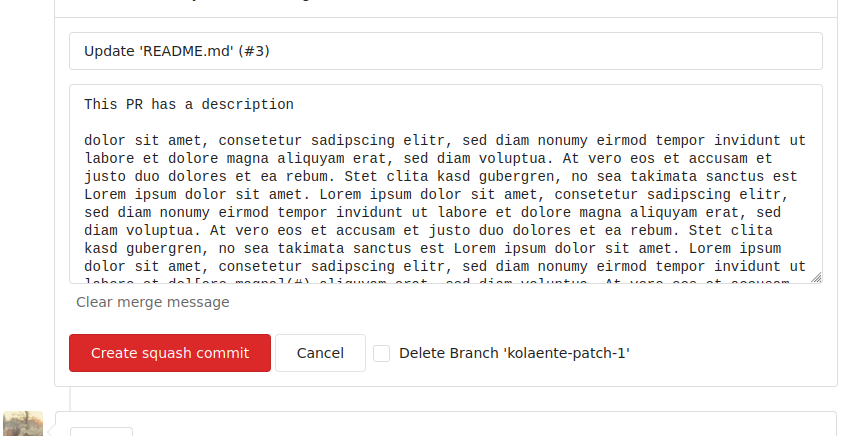This PR introduce glob match for protected branch name. The separator is
`/` and you can use `*` matching non-separator chars and use `**` across
separator.
It also supports input an exist or non-exist branch name as matching
condition and branch name condition has high priority than glob rule.
Should fix #2529 and #15705
screenshots
<img width="1160" alt="image"
src="https://user-images.githubusercontent.com/81045/205651179-ebb5492a-4ade-4bb4-a13c-965e8c927063.png">
Co-authored-by: zeripath <art27@cantab.net>
Fixes #19091
Add Feed for Releases and Tags, can be accessed through
`reponame/releases.rss`, `reponame/releases.atom`, `reponame/tags.rss`,
and `reponame/tags.atom`
Signed-off-by: Reo <reo_999@proton.me>
This PR adds a button to allow quickly clearing the merge message of a
PR. The button will remove everything but the git trailers.
I found myself often pruning the commit message before merging,
especially for PRs generated by renovate - renovate puts a very long and
detailed comment with the full changelog in each PR it opens. This
clutters the commit message. However, I want to explicitly preserve the
git commit trailers. Doing this manually works, but having a button is a
lot easier.
Screenshot:

Co-authored-by: Lunny Xiao <xiaolunwen@gmail.com>
Co-authored-by: wxiaoguang <wxiaoguang@gmail.com>
Co-authored-by: delvh <dev.lh@web.de>
When I'm trying to use a user which has no repo numbers limit to create
a repo for a org which has reached the limit, it says "You have already
reached your limit of 5 repositories."
That's confusing. "I" haven't reached the limit, the owner has.
<img width="828" alt="xnip_2022-11-10_11-57-45"
src="https://user-images.githubusercontent.com/9418365/200997290-d0819e40-fb10-4c37-917c-167e2070b4f9.png">
Co-authored-by: Lauris BH <lauris@nix.lv>
Co-authored-by: techknowlogick <techknowlogick@gitea.io>
Close https://github.com/go-gitea/gitea/issues/21640
Before: Gitea can create users like ".xxx" or "x..y", which is not
ideal, it's already a consensus that dot filenames have special
meanings, and `a..b` is a confusing name when doing cross repo compare.
After: stricter
Co-authored-by: Jason Song <i@wolfogre.com>
Co-authored-by: Lunny Xiao <xiaolunwen@gmail.com>
Co-authored-by: delvh <dev.lh@web.de>
_This is a different approach to #20267, I took the liberty of adapting
some parts, see below_
## Context
In some cases, a weebhook endpoint requires some kind of authentication.
The usual way is by sending a static `Authorization` header, with a
given token. For instance:
- Matrix expects a `Bearer <token>` (already implemented, by storing the
header cleartext in the metadata - which is buggy on retry #19872)
- TeamCity #18667
- Gitea instances #20267
- SourceHut https://man.sr.ht/graphql.md#authentication-strategies (this
is my actual personal need :)
## Proposed solution
Add a dedicated encrypt column to the webhook table (instead of storing
it as meta as proposed in #20267), so that it gets available for all
present and future hook types (especially the custom ones #19307).
This would also solve the buggy matrix retry #19872.
As a first step, I would recommend focusing on the backend logic and
improve the frontend at a later stage. For now the UI is a simple
`Authorization` field (which could be later customized with `Bearer` and
`Basic` switches):

The header name is hard-coded, since I couldn't fine any usecase
justifying otherwise.
## Questions
- What do you think of this approach? @justusbunsi @Gusted @silverwind
- ~~How are the migrations generated? Do I have to manually create a new
file, or is there a command for that?~~
- ~~I started adding it to the API: should I complete it or should I
drop it? (I don't know how much the API is actually used)~~
## Done as well:
- add a migration for the existing matrix webhooks and remove the
`Authorization` logic there
_Closes #19872_
Co-authored-by: Lunny Xiao <xiaolunwen@gmail.com>
Co-authored-by: Gusted <williamzijl7@hotmail.com>
Co-authored-by: delvh <dev.lh@web.de>
I found myself wondering whether a PR I scheduled for automerge was
actually merged. It was, but I didn't receive a mail notification for it
- that makes sense considering I am the doer and usually don't want to
receive such notifications. But ideally I want to receive a notification
when a PR was merged because I scheduled it for automerge.
This PR implements exactly that.
The implementation works, but I wonder if there's a way to avoid passing
the "This PR was automerged" state down so much. I tried solving this
via the database (checking if there's an automerge scheduled for this PR
when sending the notification) but that did not work reliably, probably
because sending the notification happens async and the entry might have
already been deleted. My implementation might be the most
straightforward but maybe not the most elegant.
Signed-off-by: Andrew Thornton <art27@cantab.net>
Co-authored-by: Lauris BH <lauris@nix.lv>
Co-authored-by: Andrew Thornton <art27@cantab.net>
Co-authored-by: Lunny Xiao <xiaolunwen@gmail.com>
The OAuth spec [defines two types of
client](https://datatracker.ietf.org/doc/html/rfc6749#section-2.1),
confidential and public. Previously Gitea assumed all clients to be
confidential.
> OAuth defines two client types, based on their ability to authenticate
securely with the authorization server (i.e., ability to
> maintain the confidentiality of their client credentials):
>
> confidential
> Clients capable of maintaining the confidentiality of their
credentials (e.g., client implemented on a secure server with
> restricted access to the client credentials), or capable of secure
client authentication using other means.
>
> **public
> Clients incapable of maintaining the confidentiality of their
credentials (e.g., clients executing on the device used by the resource
owner, such as an installed native application or a web browser-based
application), and incapable of secure client authentication via any
other means.**
>
> The client type designation is based on the authorization server's
definition of secure authentication and its acceptable exposure levels
of client credentials. The authorization server SHOULD NOT make
assumptions about the client type.
https://datatracker.ietf.org/doc/html/rfc8252#section-8.4
> Authorization servers MUST record the client type in the client
registration details in order to identify and process requests
accordingly.
Require PKCE for public clients:
https://datatracker.ietf.org/doc/html/rfc8252#section-8.1
> Authorization servers SHOULD reject authorization requests from native
apps that don't use PKCE by returning an error message
Fixes #21299
Co-authored-by: wxiaoguang <wxiaoguang@gmail.com>
Co-authored-by: Lunny Xiao <xiaolunwen@gmail.com>